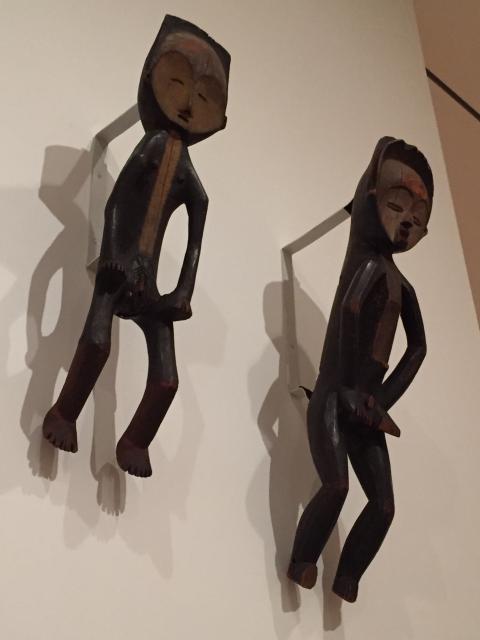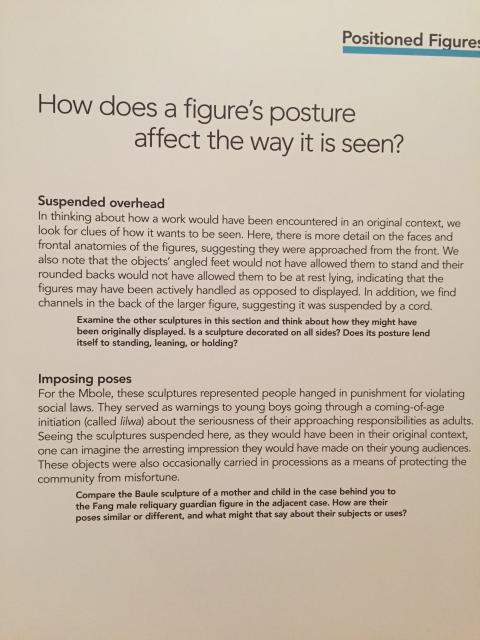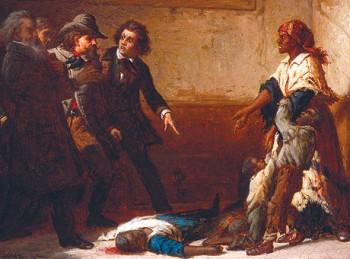September 12, 2016 - 21:36

note to self: bring poster paper, markers
I. coursekeeping
* reminder re: conferences
(Liv, Abby, Nkechi, Nyasa after class--
3:45, 4:15, 4:45, 5:15
over in English House;
Gabby and Kamara, also in EH
@ 9, 9:30 Thursday morning)
*I've asked you to "finish" Beloved by Thursday...
though we'll go on talking about it the week after,
when i'll be asking you to think-talk-feel about
the presence of ghosts, both in the novel and @ Bryn Mawr....
II. last week, I framed our discussion around
questions of transparency/opacity/access,
though our conversation v. decidedly went elsewhere....
esp. struck by Joni's saying that she didn't care
about the language--the shape of the sentences,
the structure of the novel, or questions about its
accessibility--"those are just access points for those
who don't come into it easily"; Joni's interested in
how it interacts with history/esp. interested in the
experiences black women have in reading the novel.
I was also very struck @ the end of class, when Amaka
contrasted the so-carefully crafted language that
Morrison used in writing Beloved with the less
"mediated" interview of a woman who had been
enslaved--> you said, though both stories were
common ones, about resilience in
a context of pervasive violence, that
the beauty of Morrison's writing allowed you
to feel and reflect on what she's saying--
a different experience than the visceral
one of reading the more direct, less mediated
form of the slave narrative...a way of writing
that allows you to take it in more fully?
(is this an accurate report?)
I'm evoking what Joni and Amaka said to invite us
to think some more today about the relationship
between form and content; the conventional take in
literature classes is that they are inseparable, that
what we experience is mediated, directed, dependent
on, if not entirely controlled, by how it is presented;
as Marshall McLuhan said, "the medium is the message,"
the form of the story influences how the story is perceived.
That doesn't mean they are always in synch,
or that explicating the medium always illuminates
the message, given all the different dimensions of
context that can be evoked. I'll give you an example
from our field trip on Friday (related to Sula's posting
about the inadequacy of the plaques, Rosa's about
the problematics of cultural ownership, Olivia's about
what was "hanging over her head"). Monique may have
told you that the wall plaques in the "Look Again" exhibit
were quite a departure for PMA, where the conv'l
practice is not to describe the objects for visitors,
but rather to invite us to experience them directly
(very different from what we'll see @ the Penn Museum,
where the anthropological practice is to give context,
explanation).
At the museum on Friday, I told Joni that I had an
experience of the "hanging boys" which I thought
paralleled what she had said about Beloved. When
Monique called my attention to those disturbing
sculptures, the first time we visited this summer,
they evoked, viscerally for me, the images of
lynching victims, of men's bodies hanging from trees:


The wall plaque first instructs us to attend to the "position" of the sculptures,
then it turns to a description of how they were used: they "represented
people hanged in punishment for violating social laws," and "served as
warnings to young boys...about their approaching responsibilities...";
but then the plaque returns to questions of "positionality"--and ends by
inviting us to compare the poses of various other figures nearby.
That emphasis seemed to me oblique, misplaced.
I generally like having context for a piece of fiction, and for art,
I think it helps me read less naively, to see more. (Though I also
never take the audiotours in museums--too directed, and those
objects always too crowded....)
(I think) I saw something similar happening last Tuesday,
when I asked those of you who had already read Beloved
what reading advice you had for your classmates, how
you might prepare them for their first encounter w/ the novel.
I remember your (Nkechi? Abby?) saying "just read"--
just give yourself time to read, and space to deal
w/ what you were reading. You didn't offer any explanations
of background or context...
I now invite everyone to think about that question some more.
If you were creating an exhibit of Beloved, what context
would you provide? Would you use wall plaques? If so,
what would you put on them? What would you explain?
[From Nyasa's posting: How much of the story do
we want to tell? How we tell it.]
What do you want readers/viewers to attend to?
Would you curate it with other representations of the
story of Margaret Garner (such as this dramatic,
sensationalist painting by Thomas Satterwhite Noble)?

Count off by 5 (to get 5 groups of 3-4 each).
2:40-3:00: Write a wall plaque, or create/curate an exhibition
(what images, what other texts?) You could think of this
as designing a class: how would you teach this novel
to 9th/11th grade/college students? I'm esp. interested
in the balance/imbalance of attention you give
to form and to content, and to the relation
between them...
DO THIS VISUALLY.
3:00-3:30: Come back together, and share....
(pairing the groups, or large group...?)
3:30-3:45: Close reading of pp. 210-213
"I am Beloved and she is mine..."
other passages for discussion?
p. 177: After 60 years of losing children...after five years of freedom...to belong to a community of other free Negroes...and then to have that community step back and hold itself at a distance--well, it could wear out even a Baby Suggs, holy.
p. 190: "And you telling me that's not stealing?"...."No, sir. It ain't....Improving your property, sir.".....Clever, but scholteacher beat him anyway to show him that definitions belonged to the definers--not the defined.
pp. 198-9: Whitepeople believed that whatever the manners, under every dark skin was a jungle....But it wasn't the jungle blacks brought with them to this place from the other (livable) place. It was the jungle whitefolks planted in them. And...it spread, until it invaded the whites who had made it...Made them bloody, silly, worse than even they wanted to be, so scared were they of the jungle they had made.
p. 203: My plan was to take us all to the other side where my own ma'am is. They stopped me from getting us there, but they didn't stop you from getting here. Ha ha. You came right on back like a good girl, like a daughter which is what I wanted to be and would have been if my ma'am had been able....nobody's ma'am would run off and leave her daughter, would she?
p. 220: Now...he wondered how much difference there really was between before schoolteacher and after. Garner called and announced them men....Was he naming what he saw or creating what he did not?....Did a whiteman saying it make it so?
To close: where does this conversation bring/leave us?
Where/how do we want to pick this up again,
re-enter the novel on Thursday?
